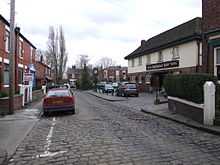Heaton Norris
| Heaton Norris | |
 Heaton Norris | |
| Population | (2001 Census) |
|---|---|
| OS grid reference | SJ885909 |
| Metropolitan borough | Stockport |
| Metropolitan county | Greater Manchester |
| Region | North West |
| Country | England |
| Sovereign state | United Kingdom |
| Post town | STOCKPORT |
| Postcode district | SK4 |
| Dialling code | 0161 |
| Police | Greater Manchester |
| Fire | Greater Manchester |
| Ambulance | North West |
| EU Parliament | North West England |
| UK Parliament | Denton and Reddish |
| |
Heaton Norris is a suburban area of Stockport, in Greater Manchester, England. It is a constituent part of the Four Heatons, and thus neighbours Heaton Chapel, Heaton Mersey and Heaton Moor. Formerly Heaton Norris was a parish of Lancashire, which spanned the whole of the Four Heatons.
In 1835 part of the parish of Heaton Norris was annexed to neighbouring Stockport in Cheshire; Heaton Chapel and Heaton Moor remained in Lancashire, but further territory was ceded in 1894 and the remnant in 1913.
History
Heaton Norris was part of the Manchester barony of the Grelley family, but between 1162 and 1180 it belonged to William le Norreys.[1] In the early 13th century, Heaton Norris was a sub manor of Manchester, it encompassed all of the Four Heatons. It was escheated (i.e. reverted) to the manor of Manchester around 1280. In 1322, there were 32 dwellings suggesting a population of 150, the ten freeholders of the escheated manor had the right to graze on common pasture and to cut wood.[2] There was no chapel of ease, unlike neighbouring St Ostwalds at Didsbury, and didn't get one till St Thomas' was built in 1758. The township remained part of the parish of Manchester in the Salford Hundred of Lancashire[3] until 1835 when the southern portion of the parish was absorbed into Stockport.[1] In 1894, under the Local Government Act 1894, it was divided again, with a portion becoming part of Stockport county borough in Cheshire, and the remaining part forming the Heaton Norris urban district in Lancashire. A further 16 acres (65,000 m2) transferred in 1901,[4] and the remainder, Heaton Moor and Heaton Chapel, was added to Stockport county borough in 1913. There was a plebiscite in the 1930 on whether the area wished to become part of Manchester again, but the vote was lost. In 1901, the population was recorded as 26,251. Since 1974 it has formed part of the Metropolitan Borough of Stockport in Greater Manchester.
Weaving was first recorded in 1580 and by 1776 farms were being advertised as having cowsheds and large loom houses.[1] In spite of the industrial developments nearby in Stockport and Manchester, most of Heaton Norris remained agricultural, though in 1836 there were 20 mills employing upwards of 5,000.[5] The rural nature changed with the arrival of the railway station at Heaton Norris in 1840 and Heaton Chapel in 1852, when the area became largely residential. The majority of Heaton Norris has terraced or semi-detached housing, though areas close to the border with Heaton Moor contain more prestigious and expensive housing.
Stockport County Football Club

Heaton Norris Rovers, now known as Stockport County Football Club was formed in 1883, and used to play on a pitch behind the Nursery Inn on Green Lane. In 1902 they left the Green Lane ground and moved to Edgeley Park.[6]
Geography
Heaton Norris, Heaton Mersey, Heaton Moor and Heaton Chapel are on the north bank of the River Mersey, and south of the Cringle Brook, to the west of Reddish and the River Tame. The land slopes gently towards the north from a high point in the south above a steep descent to the Mersey. Most of the townships are between 60 m and 70 m above sea level, and 30 m to 60 m above the river. Heaton Norris is about 7 km south of St Ann's Square, Manchester. The soil is clay on marl and red sandstone.
The former Manchester to Buxton Roman road and the later turnpike, now the A6, pass through Heaton Norris, as does the London to Manchester railway. This is carried from Edgeley to Heaton Norris by the massive brick-built Stockport Viaduct.
Along the north bank of the River Mersey ran the Great Central Railway's line from Warrington to Stockport (1852). Today this route is used by the M60 motorway; Junction 1 (formerly Junction 12 of the M63) serves Heaton Norris.
The Stockport branch of the Ashton Canal terminated at Heaton Norris.


Industry
In 1820, William Nelstrop established his flour mill on Lancashire Hill. Nelstrop's Albion Flour Mills were rebuilt on the same site in 1893 following a fire. The company is now one of Britain's largest independent flour millers.[7]
Community facilities
Some of the more notable landmarks in Heaton Norris include Bryant's Warehouse, a large B&Q superstore which was, when first opened, the largest in the country and the Bowerfold Open Space, known locally as 'The Bonks' . These are popular with locals for dog walking, horse riding and have a football pitch on one half of the open space. On the occasional days of heavy snowfall, sledging is popular too.
Heaton Norris in media
In the BBC series' The Mrs Merton Show and the spin-off sitcom, Mrs Merton and Malcolm, the title character Mrs Merton, played by Manchester native Caroline Aherne, often refers to living in the area.
See also
References
- ↑ 1.0 1.1 1.2 Heaton Moor Conservation Area Appraisal
- ↑ Medieval and early modern Manchester, G.H.Tupling in Manchester and its region, pub The British Association and Manchester University Press 1962
- ↑ Heaton Norris Tn/Ch/CP Lancashire through time | Administrative history of Parish-level Unit: hierarchies, boundaries
- ↑ Victoria County Histories
- ↑ Heaton Norris in 1841 from Butterworth
- ↑ Green Lane Conservation Area Appraisal
- ↑ http://www.nelstrop.co.uk/company-history
External links
| |||||